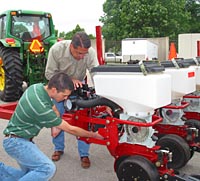Planter Designed to Reduce Guesswork, Increase Savings for Farmers
Planter Designed to Reduce Guesswork, Increase Savings for Farmers

It looks like a typical planter: a crucial piece of farm machinery that places seeds into the ground, supplies them with fertilizer and packs the soil around them – several rows at a time.
But there’s something different about this planter, developed by the University of Kentucky Biosystems and Agricultural Engineering Department. A computer network that includes 8-bit microcontrollers located at each of the machine’s eight row units eliminates much of the guesswork involved in planting. And when you eliminate the guesswork, you can start adding up the savings, said Scott Shearer, BAE professor.
“Immediately, we’ll probably see about 5 to 8 percent savings in inputs,” said Shearer, who serves as adviser to the project designer, graduate student Brandon McDonald. “If we extend that to starter fertilizer applications for spring, we’re going to see similar savings there as well.”
The technology that makes the planter unique is a controller area network (CAN), which is similar to a local area computer network used in office settings to connect personal computers together.
“Each microcontroller is essentially a personal computer complete with an operating system and memory,” Shearer said.
That enables the machine to plant a correct number of seeds per acre and maintain a constant space between those seeds – two of the most important considerations when planting and a major challenge for Kentucky farmers, many of whom plant in irregularly shaped fields.
“When you think of irregularly shaped fields,” said Shearer, “think about how much of the field is planted while turning. With existing planters, the seed at the inside row is dropped at the same rate as the seed on the outside. So on the outside row of that pass, we end up with greater plant spacing when compared with the rows at the inside of the turn. On the inside, corn can be seeded at spacing of less than 1 inch in tight turns. Therefore, spacing across a planter can vary significantly under these conditions.”
The planter also will be beneficial to Kentucky farmers who must contend with hills, steep slopes, ridgetops and bodies of water.
“In Kentucky, there’s a fair amount of skill required when utilizing larger equipment in row-crop applications,” he said. “You have to pay attention to what you’re doing, and you have to know your land pretty well. That’s what prompted us, what motivated us to develop the CAN-based planter technology.”
The idea for the planter has been on the drawing board for a couple of years, but it was McDonald, a 23-year-old from Henderson, who finally brought it to fruition.
“Technology is a big thing in agriculture now,” said McDonald, who aspires to design agricultural equipment for industry when he completes his master’s degree. “With this system, the farmer just jumps in his tractor and goes. He doesn’t even have to think about it. He would just plant like he normally would, and the microcontroller network controls everything.”
Why, then, some have asked, hasn’t someone already devised such a potentially valuable farm implement?
“Historically, the cost of the control technology could not be justified in these applications,” said Shearer, adding, however, that the price of the microcontrollers has dropped dramatically in the past 10 years.
Plus, he added, some farmers have so far been reluctant to seek out the technology.
“I think producers in Kentucky will be perhaps the greatest benefactors of this technology,” Shearer said. “We have an obligation to the people of Kentucky. We know their problems, their situations better than most anybody else does.”
Farmers might not yet be clamoring for the planter, but plenty of manufacturers have inquired about it.
“The interesting thing about this one project Brandon’s been working on is I truly have been getting calls from people around the world,” Shearer said. “The bottom line is if the farmers are willing to purchase the technology, manufacturers will provide it.”
The planter will be demonstrated at the UK Research and Education Center Field Day in Princeton July 28.
